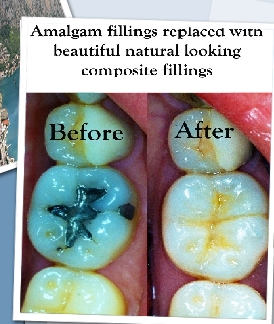Dental Bondings and White Fillings
What is it?
| |
A bonding is a non-metal composite resin that is used as an alternative to amalgams and veneers. Metal fillings (amalgam), expand and contract with temperature changes and age. Due to the expansion and contraction, metal fillings tend to crack natural teeth over time, possibly necessitating the tooth be crowned. Amalgam fillings also tend to blacken over time and can be very conspicuous. Composite dental fillings or bondings are colored to look like natural teeth. This is an excellent cosmetic option for those patients who do not want the look of silver in their mouths and do not want the expense of veneers. Composite dental fillings and bondings can be used on teeth that are decayed, cracked, or stained.
|
How is it done?
| |
The bonding procedure is usually completed in one visit. The first step is to remove the decayed, unsightly portion of the tooth or old failing restoration.The tooth is then etched with a liquid or gel and a bonding agent is then applied. This will allow the composite resin to be placed in the prepared tooth. The composite resin is then placed in layers over the opening. A special light is used to cure each layer of composite resin material. After the tooth is filled, then resin is then trimmed and polished, leaving you with a beautifully sculpted, natural-looking restoration.
|
Durability
| |
With more durable resin material available, these resins typically last from 7-10 years before they begin to chip and wear away. By contrast, the durability of amalgam fillings is well documented with the average life span of 8 to 10 years, many last 20 years or more.
Composite restorations are cosmetically pleasing and easily placed, but are not as strong as other types of restorations. Meaning, composite fillings are not ideal for larger restorations and may need to be replace one or twice.
We do not mean to say that amalgam fillings are the only option for large restorations. Larger cavities can be restored by an inlay or onlay. Or, if the structure is compromised then crowns may be the answer. Inlays, Onlays and Crowns are also available in a natural tooth color but a comprised of a different, more durable material.
~ Family & Cosmetic Dentistry ~
JOHN C. MELUCCI, D.D.S. ~ 3733 Poplar Avenue ~ Castle Shannon, PA 15234
Phone: 412.531.6804 ~ Email: jcmeluccidds@comcast.net
www.meluccidds.com
|
|
|
|
|
|



























